Location: Corner of Magnolia and Arlington
Date Established: 1873
Date Visited: 3/6/10 & 4/18/14
 California is world renowned for its citrus industry. It all started back in 1870 William Saunders, a horticulturalist at the United States Department of Agriculture, sent Eliza Tibbets a navel orange tree he had received from Bahia, Brazil. The tree got to Riverside in 1873 (not exactly speedy delivery) and it started California’s citrus industry. According to the book, A History of San Bernardino and Riverside Counties, three tree were planted. During the first year they were planted, one got trampled over by a cow and died. Later President Theodore Roosevelt in 1903 transplanted another tree to the Mission Inn Hotel. According to the hotel management that tree died in 1922 (where was the CCC on that one??). In order to protect the last tree the City of Riverside moved it to the corner of Magnolia and Arlington (which back then was the outer limits of the city) and surrounded it by a big fence.
California is world renowned for its citrus industry. It all started back in 1870 William Saunders, a horticulturalist at the United States Department of Agriculture, sent Eliza Tibbets a navel orange tree he had received from Bahia, Brazil. The tree got to Riverside in 1873 (not exactly speedy delivery) and it started California’s citrus industry. According to the book, A History of San Bernardino and Riverside Counties, three tree were planted. During the first year they were planted, one got trampled over by a cow and died. Later President Theodore Roosevelt in 1903 transplanted another tree to the Mission Inn Hotel. According to the hotel management that tree died in 1922 (where was the CCC on that one??). In order to protect the last tree the City of Riverside moved it to the corner of Magnolia and Arlington (which back then was the outer limits of the city) and surrounded it by a big fence.

This last tree is still surviving today. In fact on Saturday, March 6th, 2010 we went to go see it. Sure enough, over 100 years later this tree is still doing well. In fact, when we saw it there were plenty of oranges on it. Can you imagine? Over one hundred years and it is still bearing fruit. We cannot say if the fruit was good or not, the fence is still there. No hundred year old oranges for us!
We did make a video however:
There are also some grapefruit that was planted there in 1958, but let’s face it, who cares about 50 year old grapefruit when you can look at 100 year old oranges…
Here are some additional photos (mostly from 4/18/14), click to enlarge:
- A view of the landmark from Arlington.
- This is a picture of the tree that was planted at the Mission Inn by Theodore Roosevelt in 1903.
- The U.S. Department of Agriculture honored the tree in 1920.
- In 1976 the Tibbets tree was awarded the Heritage ’76 award from California State Historical Resources Commission.
- This plaque is dedicated 1934 but my research says the grapefruit tree was planted in 1958. So the question is where did this plaque come from and where is the other grapefruit tree that went with it?
- Another view of the Tibbets Tree.

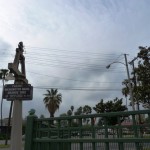
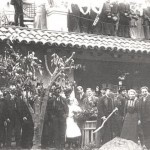
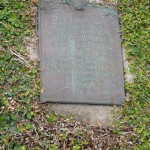
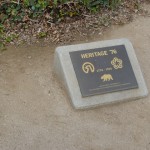
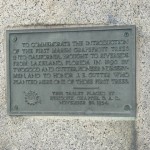

Just ate a navel orange for lunch from the tree in our backyard…our tree looks to be about as big as yours in Riverside. Reid and I have often said that the best part of living where we do is getting to eat those oranges. They are soooooo sweet and juicy–better than our neighbors’ oranges, better by far than the ones from the store! I wonder how closely they resemble the original tree? Interesting that the trees will not grow from seed. Sometimes late in the season we come across an orange with a sprouted seed inside. How do they turn green when they are hidden inside and orange?